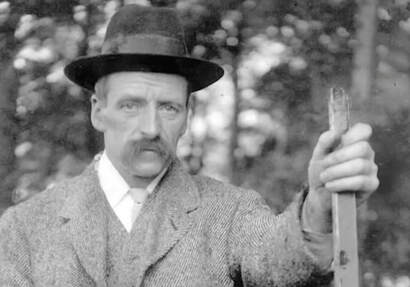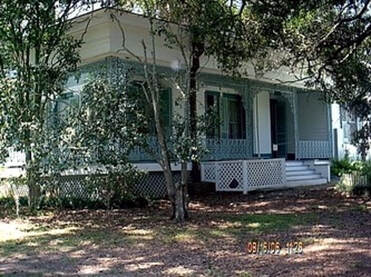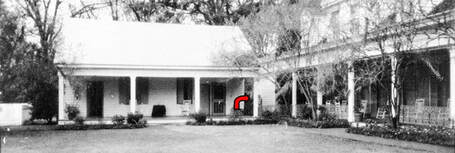Myrtles Plantation
History
 The Myrtles Plantation c.pre-Civil War
The Myrtles Plantation c.pre-Civil War
St. Francisville, Louisiana
The Myrtles Plantation was built in 1796, by General David Bradford and called Laurel Grove. He lived there alone for several years, until being pardoned for his role in the Whiskey Rebellion in 1799. He then moved his wife Elizabeth and their five children to the plantation from Pennsylvania. One of Bradford's law students, Clark Woodruff (or Woodrooff) eventually married Bradford's daughter, Sara Mathilda, in 1817. After the death of David Bradford in 1808, Clark and Sara Woodruff managed the plantation for Elizabeth Bradford. They had three children: Cornelia Gale, James, and Mary Octavia.
In July, 1823, Sara Woodruff died from yellow fever. Clark Woodruff continued to manage the plantation with his mother-in-law. James followed his mother to the grave a year later, of yellow fever as well, and his sister Cornelia Gale succumbed to the disease in August of that year. This only left Mary Octavia alive.
When Elizabeth Bradford died in 1830, Clark Woodruff and his daughter Mary Octavia moved to Covington, Louisiana, and left a caretaker to manage the plantation. In 1834, Woodruff sold the plantation, the land, and its slaves to Ruffin Gray Stirling. Woodruff eventually died in New Orleans in 1851.
The Myrtles Plantation was built in 1796, by General David Bradford and called Laurel Grove. He lived there alone for several years, until being pardoned for his role in the Whiskey Rebellion in 1799. He then moved his wife Elizabeth and their five children to the plantation from Pennsylvania. One of Bradford's law students, Clark Woodruff (or Woodrooff) eventually married Bradford's daughter, Sara Mathilda, in 1817. After the death of David Bradford in 1808, Clark and Sara Woodruff managed the plantation for Elizabeth Bradford. They had three children: Cornelia Gale, James, and Mary Octavia.
In July, 1823, Sara Woodruff died from yellow fever. Clark Woodruff continued to manage the plantation with his mother-in-law. James followed his mother to the grave a year later, of yellow fever as well, and his sister Cornelia Gale succumbed to the disease in August of that year. This only left Mary Octavia alive.
When Elizabeth Bradford died in 1830, Clark Woodruff and his daughter Mary Octavia moved to Covington, Louisiana, and left a caretaker to manage the plantation. In 1834, Woodruff sold the plantation, the land, and its slaves to Ruffin Gray Stirling. Woodruff eventually died in New Orleans in 1851.
 William Drew Winter
William Drew Winter
Stirling and his wife, Mary Catherine Cobb, undertook an extensive remodeling of the house. When completed, the new house was nearly double the size of the former building, and its name was changed to The Myrtles. The Stirlings had 9 children, but five of them died young. Stirling died in 1854 and left the plantation to his wife.
In 1865, Mary Cobb hired William Drew Winter to help manage the plantation, and he acted as her lawyer and agent. Winter was married to Mary Cobb's daughter, Sarah Mulford. Sarah and William Winter lived at the Myrtles and had six children, one of whom died from typhoid at the age of three. Although the Winters were forced to sell the plantation in 1868, they were able to buy it back two years later.
In 1865, Mary Cobb hired William Drew Winter to help manage the plantation, and he acted as her lawyer and agent. Winter was married to Mary Cobb's daughter, Sarah Mulford. Sarah and William Winter lived at the Myrtles and had six children, one of whom died from typhoid at the age of three. Although the Winters were forced to sell the plantation in 1868, they were able to buy it back two years later.
 The murder Wm. Winter c.1871 (Source - The Times Picayune)
The murder Wm. Winter c.1871 (Source - The Times Picayune)
On January 26, 1871, William Drew Winter was called to his front door, and someone discharged a double barrel gun loaded with seven large buck-shot. Five hit him in the chest and one went through his neck. He died instantly. It was believed whoever shot him was on horseback. He left a wife and five children.
This disapproves one of the legends at the Myrtles, which was that he had died on the stairs inside the home. In late May, five men were arrested who were "cognizant" of the murder, however nothing seemed to have come of it, and there is no reference to anyone being charged and convicted with his murder.
Sarah remained at the Myrtles with her mother and siblings until 1878, when she died. Mary Cobb outlived her daughter for two years only, and in 1880 the plantation passed to Stephen, one of her sons. The plantation was heavily in debt and Stephen sold it in 1886, to Oran D. Brooks. Brooks sold it in 1889, and the house changed hands several times until 1891, when it was purchased by Harrison Milton Williams.
This disapproves one of the legends at the Myrtles, which was that he had died on the stairs inside the home. In late May, five men were arrested who were "cognizant" of the murder, however nothing seemed to have come of it, and there is no reference to anyone being charged and convicted with his murder.
Sarah remained at the Myrtles with her mother and siblings until 1878, when she died. Mary Cobb outlived her daughter for two years only, and in 1880 the plantation passed to Stephen, one of her sons. The plantation was heavily in debt and Stephen sold it in 1886, to Oran D. Brooks. Brooks sold it in 1889, and the house changed hands several times until 1891, when it was purchased by Harrison Milton Williams.
 Myrtles Plantation c.2006
Myrtles Plantation c.2006
Over the next several decades, the land was split up and owned by various Williams heirs. In the 1950s, Marjorie Munson owned the house itself. Munson apparently noticed odd things happening around the house, and began to question neighbors about its history. This is possibly the beginning of some of the legends surrounding the Myrtles.
The plantation changed hands several more times and was restored in the 1970s, by owners Arlin Dease and Mr. & Mrs. Robert Ward. At some point the house changed hands again, being bought by James and Frances Kermeen Myers. The Myerses apparently believed the house was haunted, and it began to be featured in books and magazines about haunted houses. Frances, publishing as Francis Kermeen wrote a book about the Myrtles and its supposed haunting. The house is now a bed & breakfast, and offers historical and mystery tours. It is listed on the National Register of Historic Places.
The plantation changed hands several more times and was restored in the 1970s, by owners Arlin Dease and Mr. & Mrs. Robert Ward. At some point the house changed hands again, being bought by James and Frances Kermeen Myers. The Myerses apparently believed the house was haunted, and it began to be featured in books and magazines about haunted houses. Frances, publishing as Francis Kermeen wrote a book about the Myrtles and its supposed haunting. The house is now a bed & breakfast, and offers historical and mystery tours. It is listed on the National Register of Historic Places.
The Legend of Chloe
 Ghost photo at the Myrtles thought to be Chloe
Ghost photo at the Myrtles thought to be Chloe
Possibly the most well known of the Myrtles supposed ghosts, is Chloe (sometimes Cleo) who was reportedly a slave owned by Clark and Sara Woodruff. According to one story, Clark Woodruff was having sexual relations with Chloe, and his wife became aware of it. Worried that Mrs. Woodruff meant to get rid of her, Chloe began to listen at keyholes, trying to learn what would happen to her. Other versions of the legend have Chloe listening in at keyholes to learn news of Clark Woodruff's business dealings or for other purposes. After being caught, either by Clark or Sara Woodruff, one of her ears was cut off, and she wore a green turban to hide it.
After having her ear cut off, Chloe supposedly baked a birthday cake containing oleander leaves, which are extremely poisonous. The various legends diverge as to why she did this, with some saying she was getting revenge on the Woodruffs, and some say she was attempting to redeem her position by curing the family of the poisoning. According to the legend, her plan backfired. Only Sara and her two daughters ate the cake, and all died from the poison. Chloe was then supposedly hanged by the other slaves, either as punishment or to escape retribution by Clark Woodruff for harboring her.
The historical record does not support this legend. There is no record of the Woodruffs owning a slave named Chloe or Cleo. The story usually claims that Sara and her two daughters were poisoned, but Mary Octavia survived well into adulthood. Finally, Sara, James, and Cornelia Woodruff were not killed by poisoning, but instead succumbed to yellow fever.
It seems the story of Chloe is totally made up. The famous picture of who is thought to be Chloe walking between the buildings could have been any person. During those years it was common for female slaves to wear turbans, and not because their ear had been cut off.
After having her ear cut off, Chloe supposedly baked a birthday cake containing oleander leaves, which are extremely poisonous. The various legends diverge as to why she did this, with some saying she was getting revenge on the Woodruffs, and some say she was attempting to redeem her position by curing the family of the poisoning. According to the legend, her plan backfired. Only Sara and her two daughters ate the cake, and all died from the poison. Chloe was then supposedly hanged by the other slaves, either as punishment or to escape retribution by Clark Woodruff for harboring her.
The historical record does not support this legend. There is no record of the Woodruffs owning a slave named Chloe or Cleo. The story usually claims that Sara and her two daughters were poisoned, but Mary Octavia survived well into adulthood. Finally, Sara, James, and Cornelia Woodruff were not killed by poisoning, but instead succumbed to yellow fever.
It seems the story of Chloe is totally made up. The famous picture of who is thought to be Chloe walking between the buildings could have been any person. During those years it was common for female slaves to wear turbans, and not because their ear had been cut off.
 The poisoning of the Lafargue family c.1853 (Source - The Opelousas Courier)
The poisoning of the Lafargue family c.1853 (Source - The Opelousas Courier)
THE POSSIBLE ORIGIN OF THE CHLOE LEGEND
In 1853, Pierre Adolphe Lafargue who lived in Avoyelles parish in Louisiana acquired a 17-year-old mulatto slave named Charlotte. She cost him $1040 ($42K present day). She poisoned one of Mr. Larfargue's children who died. Two days later she tried to poison the entire family using arsenic infused coffee. She ran away after this and was caught by the police. She confessed to poisoning 9 different persons in the state of Missouri. What became of Charlotte is unknown.
The distance from Saint Francisville to Avoyelles Parish is only 72 miles.
In 1853, Pierre Adolphe Lafargue who lived in Avoyelles parish in Louisiana acquired a 17-year-old mulatto slave named Charlotte. She cost him $1040 ($42K present day). She poisoned one of Mr. Larfargue's children who died. Two days later she tried to poison the entire family using arsenic infused coffee. She ran away after this and was caught by the police. She confessed to poisoning 9 different persons in the state of Missouri. What became of Charlotte is unknown.
The distance from Saint Francisville to Avoyelles Parish is only 72 miles.
Other Legends
 Mirror at the Myrtles c.2006
Mirror at the Myrtles c.2006
There are a variety of other legends surrounding the Myrtles. The house is reputedly built over an Indian burial ground, and the ghost of a young Indian woman has been reported. During the Civil War, the house was ransacked by Union soldiers, and legend claims that three were killed in the house. Supposedly, there is (or was) a blood stain in a doorway, roughly the size of a human body, that will not (or would not) come clean. Other legends say that cleaners have been unable to push their mop or broom into that space. However, there is no record of any Union soldiers having been shot on the Myrtles property.
A mirror located in the house supposedly holds the spirits of Sara Woodruff and two of her children. According to custom, mirrors are covered after a death, but legend says that after the poisoning of some of the Woodruffs, this particular mirror was overlooked. The uncovered mirror reportedly trapped the spirits of Sara and her children, who are occasionally seen or leave their handprints in the mirror. The prints may have been left by workers replacing the glass or resilvering the mirror.
The plantation is also reportedly haunted by a young girl who died in 1868, despite being treated by a local voodoo practitioner. She supposedly appears in the room in which she died, and has been reported to practice voodoo on people sleeping in the room. There is also a ghost who reportedly walks, staggers, or crawls up the stairs and stops on the 17th step. Some have said that this is William Winter, the victim of the only reported murder in the house. Alternate versions of his murder claim he managed to walk or crawl up the stairs, and collapsed in his wife's arms on the 17th step. However, this version of the story is contested. There have been other reports of odd sounds, but they generally do not have legends attached to them.
Most of the stories connected to the supposed hauntings are false, which means most of these ghosts have been manufactured, however that doesn't mean The Myrtles isn't haunted, in truth the mystery surrounds who exactly were they in life.
A mirror located in the house supposedly holds the spirits of Sara Woodruff and two of her children. According to custom, mirrors are covered after a death, but legend says that after the poisoning of some of the Woodruffs, this particular mirror was overlooked. The uncovered mirror reportedly trapped the spirits of Sara and her children, who are occasionally seen or leave their handprints in the mirror. The prints may have been left by workers replacing the glass or resilvering the mirror.
The plantation is also reportedly haunted by a young girl who died in 1868, despite being treated by a local voodoo practitioner. She supposedly appears in the room in which she died, and has been reported to practice voodoo on people sleeping in the room. There is also a ghost who reportedly walks, staggers, or crawls up the stairs and stops on the 17th step. Some have said that this is William Winter, the victim of the only reported murder in the house. Alternate versions of his murder claim he managed to walk or crawl up the stairs, and collapsed in his wife's arms on the 17th step. However, this version of the story is contested. There have been other reports of odd sounds, but they generally do not have legends attached to them.
Most of the stories connected to the supposed hauntings are false, which means most of these ghosts have been manufactured, however that doesn't mean The Myrtles isn't haunted, in truth the mystery surrounds who exactly were they in life.










